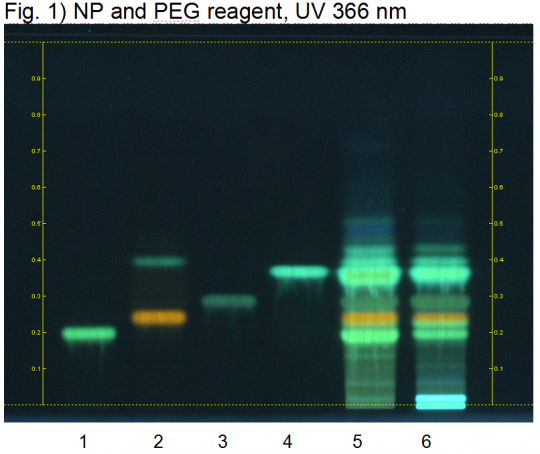Silybum marianum (fruit)
(addition of hptlc info.--jd) |
(to new format) |
||
| Line 1: | Line 1: | ||
| − | = | + | {{DISPLAYTITLE:''Silybum marianum'' (fruit)}} |
| − | =Macroscopic | + | =Nomenclature= |
| − | =Microscopic | + | |
| − | = | + | =Botanical Voucher Specimen= |
| + | |||
| + | =Organoleptic Characteristics= | ||
| + | |||
| + | =Macroscopic Descriptions= | ||
| + | |||
| + | =Microscopic Characteristics= | ||
| + | |||
| + | =High Performance Thin Layer Chromatographic Identification= | ||
| + | |||
{{HPTLC | source=HPTLC Association | {{HPTLC | source=HPTLC Association | ||
| companyimage=HPTLC-assoc-Logo-farbig-Text-schwarz-300x47.png | | companyimage=HPTLC-assoc-Logo-farbig-Text-schwarz-300x47.png | ||
| Line 33: | Line 42: | ||
| }} | | }} | ||
| − | = | + | |
| − | + | =Supplementary Information= | |
| − | [[Category: | + | |
| + | =Sources= | ||
| + | |||
| + | <references /> | ||
| + | [[Category:Botanical]] | ||
Revision as of 19:54, 18 February 2014
Contents |
Nomenclature
Botanical Voucher Specimen
Organoleptic Characteristics
Macroscopic Descriptions
Microscopic Characteristics
High Performance Thin Layer Chromatographic Identification
|
Milk thistle (fruit) (Silybum marianum) Lane Assignments Lanes, from left to right (Track, Volume, Sample):
Reference Sample(s) Reference: Dissolve 1 mg of silybin in 10 mL of methanol; Dissolve 1 mg of silychristin in 10 mL of methanol; Optional: individually dissolve 1 mg of silydianin and taxifolin each in 10 mL of methanol. Stationary Phase Stationary phase, i.e. Silica gel 60, F254 Mobile Phase Chloroform, acetone, formic acid 75:16.5:8.5 (v/v/v) Sample Preparation Method Sample: Mix 1 g of powdered sample with 10 mL of methanol and heat at 70°C for 5 minutes, then centrifuge or filter the solutions and use the supernatants / filtrates as test solutions. Derivatization reagent: 1.) NP reagent, Preparation: 1 g of natural products reagent in 200 mL of ethyl acetate; 2.) PEG reagent, Preparation: 10 g of polyethylene glycol 400 in 200 mL of methylene chloride, Use: Heat plate 3 min at 100 °C, dip (time 0, speed 5) in NP reagent, dry and dip (time 0, speed 5) in PEG reagent. Detection Method Saturated chamber; developing distance 70 mm from lower edge; relative humidity 33% Other Notes Images presented in this entry are examples and are not intended to be used as basis for setting specifications for quality control purposes. System suitability test: Silychristin: green fluorescent zone at Rf ~ 0.20; Silybin: green fluorescent zone at Rf ~ 0.38. Identification: Compare result with reference images. The fingerprint of the test solution is similar to that of the corresponding botanical reference sample. Additional weak zones may be present. The chromatogram of the test solution shows a green zone at Rf ~ 0.20 corresponding to reference substance silychristin. There is a green zone at Rf ~ 0.29 (silydianin) and another intense green zone at Rf ~ 0.38 corresponding to reference substance silybin. Reference substance taxifolin shows two zones, an orange zone at Rf ~ 0.26 and a green zone at Rf ~ 0.40 which are both visible in the chromatogram of the test solution.
|
Supplementary Information
Sources
- ↑ HPTLC Association http://www.hptlc-association.org/
